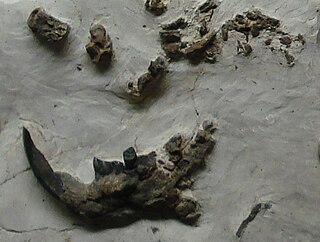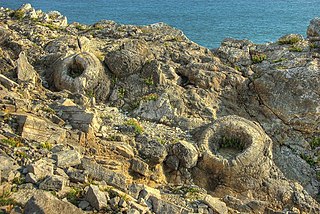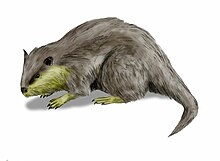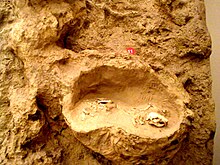
Castoridae is a family of rodents that cointains the two living species of beavers and their fossil relatives. A formerly diverse group, only a single genus is extant today, Castor. Two other genera of "giant beavers", Castoroides and Trogontherium, became extinct in the Late Pleistocene.

Steneofiber is an extinct genus of beavers from the Miocene. They contain several species of beavers. Amongst them are S.barbouri, S.complexus, S.depereti, S.fossor, S.gradatus, and S.hesperus. Their various species are found all the way from the eastern end of the Iberian peninsula to southern Japan. S.depereti has been found in northwest Germany.

The Gnathorhizidae are an extinct family of lungfish that lived from the late Carboniferous until the middle Triassic. Gnathorhizid fossils have been found in North America, Madagascar, Australia, and possibly Eastern Europe and South Africa. They are characterized by high-ridged toothplates that form cutting blades and a reduction in cranial bones.

The Lystrosaurus Assemblage Zone is a tetrapod assemblage zone or biozone which correlates to the upper Adelaide and lower Tarkastad Subgroups of the Beaufort Group, a fossiliferous and geologically important geological Group of the Karoo Supergroup in South Africa. This biozone has outcrops in the south central Eastern Cape and in the southern and northeastern Free State. The Lystrosaurus Assemblage Zone is one of eight biozones found in the Beaufort Group, and is considered to be Early Triassic in age.

The Tropidostoma Assemblage Zone is a tetrapod assemblage zone or biozone which correlates to the lower Teekloof Formation, Adelaide Subgroup of the Beaufort Group, a fossiliferous and geologically important geological Group of the Karoo Supergroup in South Africa. The thickest outcrops, reaching approximately 240 metres (790 ft), occur from east of Sutherland through to Beaufort West and Victoria West, to areas south of Graaff-Reinet. Its northernmost exposures occur west/north-west of Colesberg. The Tropidostoma Assemblage Zone is the fourth biozone of the Beaufort Group.

A zooid or zoöid is a single animal that is part of a colonial animal. This lifestyle has been adopted by animals from separate unrelated taxa. Zooids are multicellular; their structure is similar to that of other solitary animals. The zooids can either be directly connected by tissue or share a common exoskeleton. The colonial organism as a whole is called a zoon, plural zoa.

Gnathorhiza is an extinct genus of prehistoric lobe-finned fish (lungfish) which lived from the Carboniferous period to the Early Triassic epoch. It is the only known lungfish genus to have crossed the Permo-Triassic boundary. Several species have been described, ranging in size from 5 to 50 centimeters.
Zodiolestes is a genus of mustelids, now extinct, which existed during the Miocene period.
The Chenini Member is a geological member of the Ain el Guettar Formation in Tunisia, whose strata date back to the Late Aptian to Early Albian stages of the Cretaceous period. The lithology consists of coarse sandstones with occasional conglomerates and mudstones. Dinosaur remains are among the fossils that have been recovered from the formation.

Ophiomorpha is an ichnotaxon, usually interpreted as a burrow of an organism living in the near-shore environment. The burrow lining is more or less smooth on the inside, and densely to strongly mammalated or nodose on the outside, due to the packing of nodules for support of the burrow. Branching is irregular but Y-shaped where present. It is often considered part of the Skolithos ichnofacies, where it has occurred since the early Permian, though it has also occurred in deep water settings since the Late Jurassic, such as well-oxygenated turbidites.
Mioceratodus is an extinct genus of lungfish in the family Neoceratodontidae, which also contains the extant Queensland lungfish. It is known only from Oligocene and Miocene-aged sediments in Australia, although phylogenetic evidence supports it having first diverged from its closest relative, Neoceratodus, during the Late Jurassic or Early Cretaceous period.

The Fossil Forest is the remains of an ancient submerged forest from Jurassic times, located to the east of Lulworth Cove on the Isle of Purbeck in Dorset, England. It lies on the Jurassic Coast, on a wide ledge in the seaside cliff. The site is within the Lulworth Ranges and thus has restricted access. Parts of forest can also be seen on the Isle of Portland and in quarries near the town of Weymouth to the west.

Persististrombus coronatus is an extinct species of fossil true conch from the Late Miocene to Pliocene.

Frondosity is the property of an organism that normally flourishes with fronds or leaf-like structures.
The Aïn el Guettar Formation is a geological formation in Tunisia, whose strata date back to the Late Aptian to Early Albian stages of the Cretaceous period. The lithology consists of coarse sandstones with occasional conglomerates and mudstones. Dinosaur remains are among the fossils that have been recovered from the formation.

Aphanius crassicaudus is an extinct species of fish in the family Cyprinodontidae. It lived in the Late Miocene in brackish and hypersaline lagoons along the northern coast of the Mediterranean Sea. Fossils are known from Greece, Italy, and Spain.

Lenisambulatrix is a genus of extinct worm belonging to the group Lobopodia and known from the Lower Cambrian Maotianshan shale of China. It is represented by a single species L. humboldti. The incomplete fossil was discovered and described by Qiang Ou and Georg Mayer in 2018. Due to its missing parts, its relationship with other lobopodians is not clear. It shares many structural features with another Cambrian lobopodian Diania cactiformis, a fossil of which was found alongside it.
Longchuansmilus is an extinct genus of machairodontine (sabre-toothed) cat that lived in China during the Late Miocene. The type and only species, Longchuansmilus xingyongi, was described in 2022.

Plesiotypotherium is an extinct genus of Notoungulate, belonging to the suborder Typotheria. It lived from the Middle to the Late Miocene, and its fossilized remains were discovered in South America.
Brucemacfaddenia is an extinct genus of interatheriine notoungulates that lived during the Late Oligocene in what is now Bolivia. Fossils of this genus have been found in the Salla Formation of Bolivia.

















